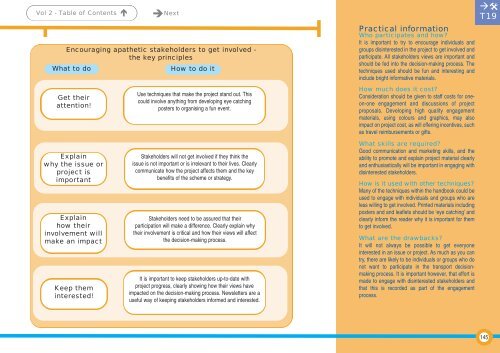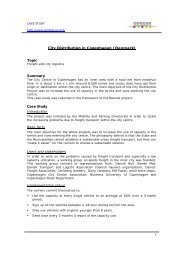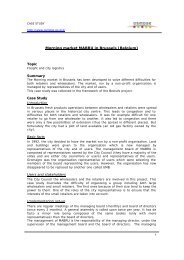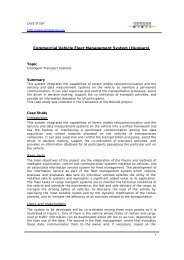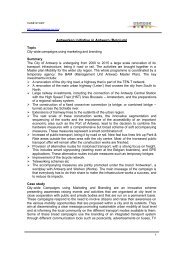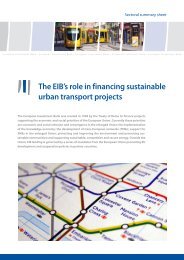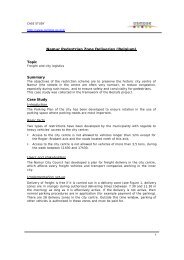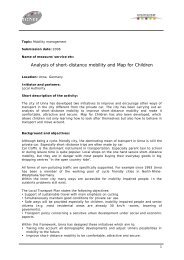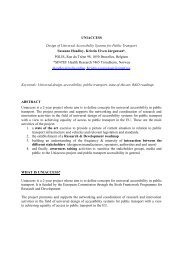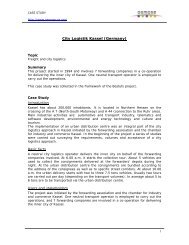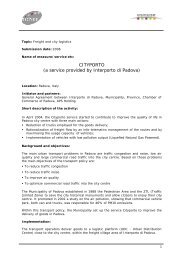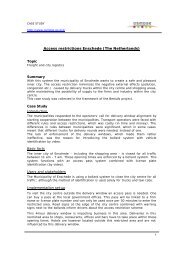Successful transport decision-making - Osmose
Successful transport decision-making - Osmose
Successful transport decision-making - Osmose
You also want an ePaper? Increase the reach of your titles
YUMPU automatically turns print PDFs into web optimized ePapers that Google loves.
Vol 2 - Table of Contents <br />
Next<br />
Encouraging apathetic stakeholders to get involved -<br />
the key principles<br />
What to do<br />
Get their<br />
attention!<br />
How to do it<br />
Use techniques that make the project stand out. This<br />
could involve anything from developing eye catching<br />
posters to organising a fun event.<br />
Practical information<br />
Who participates and how?<br />
It is important to try to encourage individuals and<br />
groups disinterested in the project to get involved and<br />
participate. All stakeholders views are important and<br />
should be fed into the <strong>decision</strong>-<strong>making</strong> process. The<br />
techniques used should be fun and interesting and<br />
include bright informative materials.<br />
How much does it cost?<br />
Consideration should be given to staff costs for oneon-one<br />
engagement and discussions of project<br />
proposals. Developing high quality engagement<br />
materials, using colours and graphics, may also<br />
impact on project cost, as will offering incentives, such<br />
as travel reimbursements or gifts.<br />
<br />
T19<br />
Explain<br />
why the issue or<br />
project is<br />
important<br />
Explain<br />
how their<br />
involvement will<br />
make an impact<br />
Keep them<br />
interested!<br />
Stakeholders will not get involved if they think the<br />
issue is not important or is irrelevant to their lives. Clearly<br />
communicate how the project affects them and the key<br />
benefits of the scheme or strategy.<br />
Stakeholders need to be assured that their<br />
participation will make a difference. Clearly explain why<br />
their involvement is critical and how their views will affect<br />
the <strong>decision</strong>-<strong>making</strong> process.<br />
It is important to keep stakeholders up-to-date with<br />
project progress, clearly showing how their views have<br />
impacted on the <strong>decision</strong>-<strong>making</strong> process. Newsletters are a<br />
useful way of keeping stakeholders informed and interested.<br />
What skills are required?<br />
Good communication and marketing skills, and the<br />
ability to promote and explain project material clearly<br />
and enthusiastically will be important in engaging with<br />
disinterested stakeholders.<br />
How is it used with other techniques?<br />
Many of the techniques within the handbook could be<br />
used to engage with individuals and groups who are<br />
less willing to get involved. Printed materials including<br />
posters and and leaflets should be ‘eye catching’ and<br />
clearly inform the reader why it is important for them<br />
to get involved.<br />
What are the drawbacks?<br />
It will not always be possible to get everyone<br />
interested in an issue or project. As much as you can<br />
try, there are likely to be individuals or groups who do<br />
not want to participate in the <strong>transport</strong> <strong>decision</strong><strong>making</strong><br />
process. It is important however, that effort is<br />
made to engage with disinterested stakeholders and<br />
that this is recorded as part of the engagement<br />
process.<br />
145


